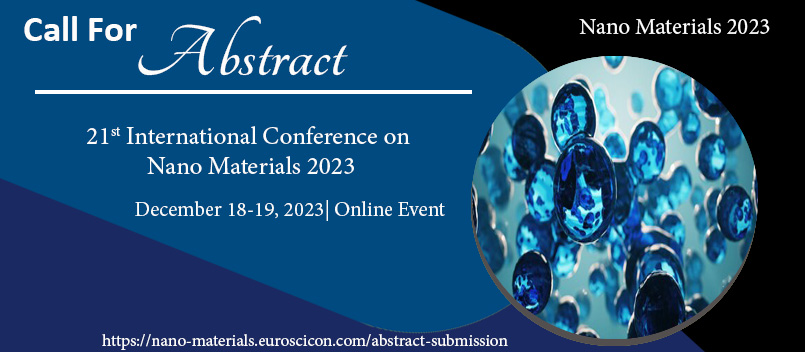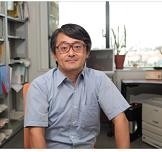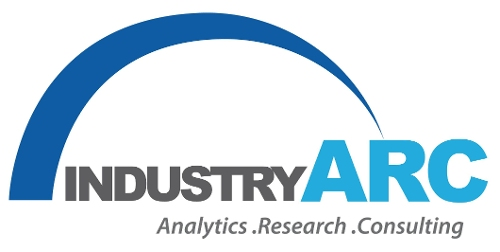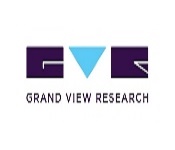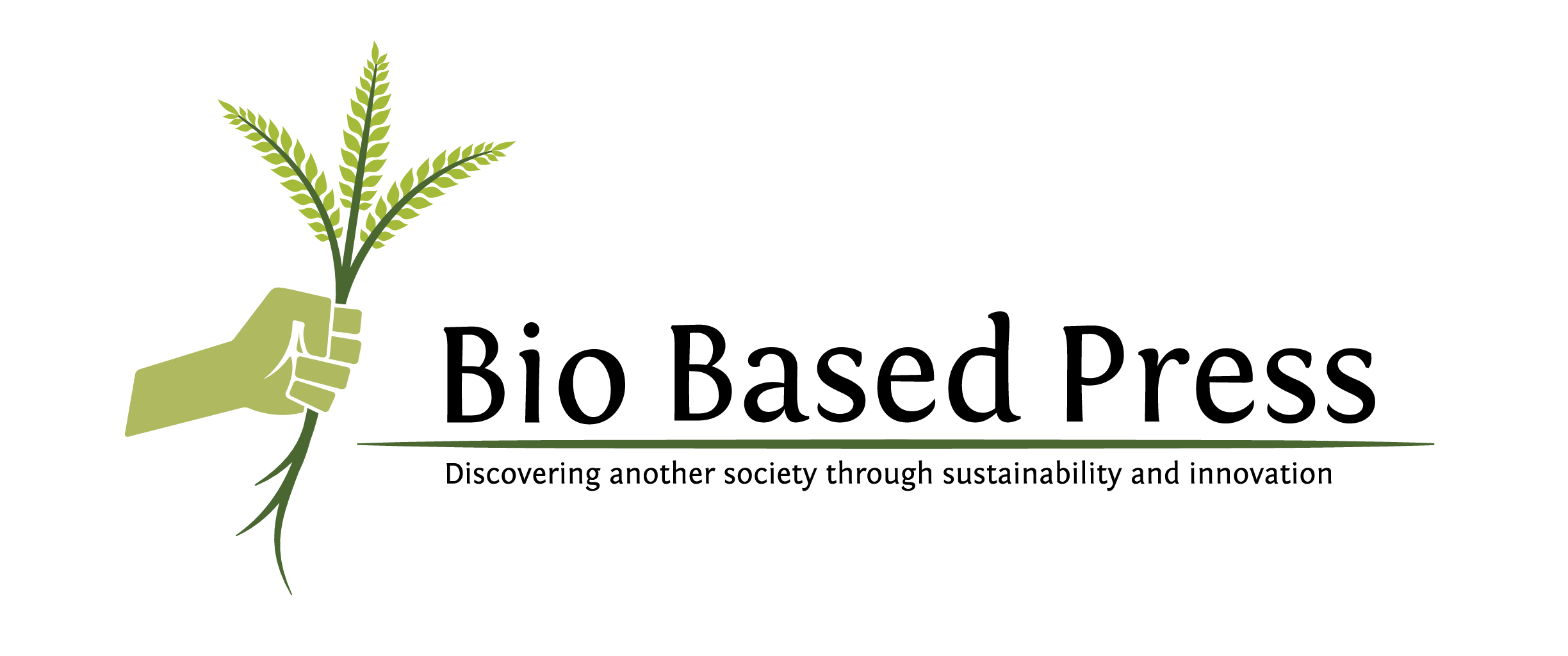Nano Materials 2023
About Conference
EuroSciCon warmly welcomes to all the experts in the field of Materials Science and Nanotechnology to attend its upcoming conference on Nanomaterials, to be held during December 18-19,2023 as a webinar/online event The Conference is based on the Theme: Advancing the research trends on Nanomaterials
As it brings together presenters, eminent speakers, businesspeople, CEOs, from all over the world to the most exciting and unforgettable event Nanomaterials-2023 Conference will make the ideal venue for international networking. One of the key determinants of the economic might of rich and emerging nations alike is the advancement of materials science and nanotechnology. We hope to hear you at Nanomaterials Conference 2023 Webinar
EuroSciCon are corporate members of the following organisations:
- Royal Society of Biology
- IBMS
- British Society for Immunology
- Rare Care UK
OPPURTUNITIES FOR ATTENDEES
- Speaker Presentations
- Poster Display
- Symposium hosting
- Workshop organizing
For Universities, Associations & Societies:
- Association Partnering
- Collaboration proposals
- Academic Partnering
- Group Participation
For Students & Research Scholars:
- Poster Competition (Winner will get Best Poster Award)
- Young Researcher Forum (YRF Award to the best presenter)
- Student Attendee
- Group registrations
For Business Delegates:
- Speaker Presentations
- Symposium hosting
- Book Launch event
- Networking opportunities
- Audience participation
- Exhibitor and Vendor booths
- Sponsorships opportunities
- Product launch
- Workshop organizing
- Scientific Partnering
- Marketing and Networking with clients
EuroSciCon organizes International Nanomaterials meetings annually across Europe, Austria, Ireland, Germany, France, Liechtenstein, Lithuania, Finland, Luxembourg, Hungary, Italy, Norway, Poland, Denmark, Macedonia, Greece, Portugal, Romania, Czech Republic, Switzerland, United Kingdom, Belgium, Scotland, Latvia, Ukraine, Sweden, Denmark, Spain, Netherlands Russia, Bulgaria, France, with solitary subject of quickening logical revelations.
Topics:
- Nano Medicine and Nano Sensors
- Utilizations of Nanotechnology in Corona Virus Diagnosis and Treatment
- Materiomics
- Organic and Inorganic Hybrid Nanomaterials
- Nanotoxicology
- Ceramic Matrix and Bio-Nano composites
- Green Nanotechnology
- Nano robotics
- Nanotechnology in Agriculture and Food Industry
- Nano chemistry and Wet Nanotechnology
- Electrical, Optical, and Magnetic Materials
- Nano Materials and Nanotechnology
- Nanobiotechnology
- Advanced Nanomaterials
- Nuclear Materials and Radiation
- Functional Nanomaterials and Their Applications
- Nanomaterials Safety and regulations
- Future of nanotechnology and nanomaterials
- Nano Catalysis & Applications in The Chemical Industry
- Nano Engineering
- Nano Characterization and Nano Manufacturing
Target Audience:
Materials scientists and research professors, physicists and chemists, materials science students, directors of chemical companies, materials engineers, members of various materials science associations, research scholars and students, nanotechnology companies, nanotechnology associations, and materials science and nanotechnology engineers.
Why to attend???
The International Conference on Nanomaterial’s 2023, which will be the largest conference for professionals in the field of nanomaterial’s and nanotechnology, will offer a world-class technical forum for reporting, learning about, and debating the latest new generation technologies that have been created over time. Hot issue presentations from around the globe are part of the events, which also feature professional networking with leading working groups and panels from many industries. Meet Your Objective Business sector with individuals from and around the globe concentrated on finding out about This is your finest chance to attract the largest membership from all around the world to Materials Science and Nanotechnology. At this time, put on shows, provide information, interact with customers, introduce another product offering, and achieve name recognition. This conference will feature highly regarded speakers as well as the most recent techniques, approaches, and advancements in materials science and nanotechnology.
Scope and Importance:
Materials Science and Nanotechnology is a broad, diverse and multidisciplinary field. It is continuous interaction with basic disciplines and is also contributing to meet all Grand Societal Challenges. This contribution is such that numerous reports have been produced in recent years in Asia and world - wide, with the aim of drawing a comprehensive picture and proposing coordinated actions towards the establishment of coherent strategies in the field. The present report subscribes to this perspective, with a particular goal which is to contribute to the establishment of a comprehensive view of the role in efficient development of key enabling technologies.
Branches of Nanomaterials Includes:
Thermodynamics of materials|Fundamentals of Nanomaterials |Amorphous Materials|Nanomaterials in Human Experience|Mechanics of Nanomaterials| Magnetic Materials |Molecular Principles of Biomaterials | Composite Materials | Optical Materials and Plasmonics | Nanotechnology in communications & Information Technology |Nanotechnology in Healthcare |Green technology |Nanotechnology in Energy
Sessions and Tracks
Track 1: Nano Medicine and Nano Sensors
Nano Medicine
Nanomedicine is a branch of medicine that applies the knowledge and techniques of this field to the prevention and treatment of disease. Nanomedicine involves the use of tiny materials in living things for diagnostics, delivery, detection, and incitation. Examples include biocompatible nanoparticles and nanorobots. The creation of novel drugs as well as the reformulation of current ones has been aided by the burgeoning field of study in nanomedicine. Changes in the harmfulness, solubility, and bioavailability characteristics of medications are brought about by nanotechnology.
Nano Sensors
Nanosensors are devices with a distinctly small size (Nano scale in scale) that function similarly to sensors in that they can detect minute particles or small amounts of anything. Nano sensors are chemical or mechanical devices that can be used to monitor physical properties like temperature as well as identify compound species and nanoparticles on the Nano scale. Nanosensors are useful for a variety of contemporary applications, including precision horticulture, urban farming, plant nanobionics, prognostics and diagnostics, SERS-based sensors, and many more.
- Nano Sensors in Defense and military
- Nano Sensors in Food and the climate
- Nano biosensors
- Nano biosensors for analysis of sickness
Track 2 : Utilizations of Nanotechnology in Corona Virus Diagnosis and Treatment
Because of the high rate of transmission and adaptability of the illness, combating Covid contaminations is a major concern for healthcare systems. There is tremendous promise for using nanotechnology to diagnose, treat, and prevent COVID-19. It has been demonstrated that a few Nano-based features can increase the useful viability and target conveyance of antiviral drugs. Another interesting alternative is a new era of vaccinations dependent on various nanomaterial’s, with better antigen dependability, target conveyance, and controlled-discharge. Nanotechnology-based solutions for COVID-19 infection the CEOs include the development of innovations for quick, exact, and delicate determination, the assembly of potent sanitizers, the delivery of mRNA antibodies into human cells, and the delivery of antiviral medications into the body.
- Nanosensors For Diagnosing
- Nanoparticles in COVID-19 Testing
- Bio-Nano Interface Technology
- Nanotherapies For COVID-19 Management
- Biomedical Nanotechnology
- Nanomaterials
Track 3 : Materiomics
Materiomics is a new field of study that provides a foundation for multiscale material framework representation, with some support from common materials like protein-based ones. Here, we lay out the scope and explain the theoretical underpinnings of the discipline of materiomics as well as the benefits of a materiomic approach to the understanding of natural and synthetic materials as well as the design of new materials. We discuss ongoing studies that best illustrate the impact of materiomics by uncovering the complexity of Nature using a materials science approach that unifies concepts of material and construction across all scales and brings together critique groups that focus on identifying and bringing about underlying changes at various scales.
The evolution and application of materiomics are defined for the specific case of protein-based materials, which define the structural squares of a variety of organic frameworks, including ligament, bone, skin, bug silk, cells, and tissue, as well as common composite material frameworks (a combination of protein-based and inorganic constituents, such as nacre and mollusk shells, and other common multiscale frameworks, such as cellulose-based plant and wood). These materials have the notable property of exhibiting distinctive progressive designs at various scales, where macroscale mechanical interactions exhibit subatomic nuances.
- Genomics
- Bio nanotechnology
- Proteomics
- Raman spectroscopy
Track 4 : Organic and Inorganic Hybrid Nanomaterial’s
Natural inorganic materials that cross over are wonderful replicas of conventional structures. These challenging normal composites achieve their qualities by a complex, million-year-advanced streamlined diverse levels assembly that is extremely difficult to replicate. Combining the principles of nanotechnology with outstanding engineering methods based on supramolecular science and the norms of self-gathering/association increases the possibility of obtaining more in-demand practical materials for the creation of Nano size devices and machinery. Interdisciplinary forces at the intersection of nanotechnology, natural science, life sciences, and biotechnology gave rise to the concept of nano architectonics.The plan of crossover nanomaterial’s, for instance the advancement of new stages for drug conveyance and of improvements responsive shrewd materials and sensors, gives an extraordinary main thrust to the quick advancement in a few examination regions including Nano medicine, modern innovations, materials science, and energy applications.
- Formation of organic polymers in presence of preformed inorganic materials
- Hybrid Materials by simultaneous formation of both components
- Distinction between nanocomposites and hybrid materials
- Nanocomposite based dental Filling Materials
Track 5 : Nanotoxicology
A growing field known as nanotoxicology studies the effects of ultrafine particles on the environment. The field of toxicology known as nanotoxicology focuses on the dangers of nanomaterials beginning with the methods used to create them, such as shower drying or granulating, burning cycles, such as diesel ash, and naturally occurring processes, such as air reactions or volcanic emissions. According to cell cycle, some cell subpopulations are generally more damaging to nanoparticles than others. Determining the harmful/dangerous effects of nanoparticles and nanopharmaceuticals on individuals and the environment is the focus of nanotoxicological study. Working on the type of information shown in Nanotoxicology considerations, notably in the area of test object representation, is a priority for toxicological and logical diaries that disseminate findings from those investigations.
- Toxicological evaluation of fabricated Nanoparticles
- Impacts of Nanotoxicology in Nanomaterial’s
- Effects of Nanoparticle plan in Nanotoxicology
- Various kinds of Nanotoxicology
- Decrease in harmfulness while keeping up with remedial impacts
Track 6 : Ceramic Matrix and Bio-Nano composites
In reality, ceramic nano composites are increasingly being used in the development of innovative handling techniques that enable the creation of goods to move from research center evaluation to the commercial level. With the help of a high energy ball processing procedure, nanoparticles can be produced. Mechanical processing techniques can be used to produce Nano-size particles on a wide scale and are also effective (Dindarsafa et al., 2017). During the processing phase, the dynamic energy produced by the processing system is transferred from the ball to the powder (Dindarsafa et al., 2017). Numerous factors, including as the types of factories, the powder used during processing, speed, ball size, dry or wet processing, processing temperature, and processing duration, are used to indicate the exchange of dynamic energy.
- Developments for applications in space
- Properties under tensile and bending loads, crack resistance
- Thermal and electrical properties
- Matrix Forming Via Chemical Reaction
- Pyrolysis
- Ceramic Fibers
Track 7 : Green Nanotechnology
By using nanomaterials as catalysts, current manufacturing processes will be more efficient and the use of hazardous compounds, as well as the generation of annoying side effects and effluents, will be reduced or eliminated.
Studies have looked at improving contemporary cycles and materials using nanotechnology, developing new modern and compound techniques, and developing materials that can replace dangerous cycles and constituents, resulting in reductions in material, energy, and waste age. There is a general consensus that nanotechnologies will primarily influence developing "green" and "clean" innovations with significant ecological benefits. The best examples involve the use of nanotechnology in fields like hydrogen applications, energy advancements, and water purification.
- Nanotechnology In Water Treatment
- Water purification Technology
- Nano remediation & water treatment
- Water Filtration
- Nano sorbents water treatment
- Nanotech in disinfected water
Track 8 : Nano robotics
Advanced mechanics can be defined as the idea and application of robotics, a fully autonomous electronic, electric, or mechanical device, to tasks like assembly.
Scale that robot down to a few billionths of a meter, and you're talking advanced nanotechnology mechanics—or, in short, nano robotics. Nanofabrication techniques used to produce Nano motors, Nano actuators, Nano sensors, and real demonstrating at Nano sizes all come together in the topic of Nano robotics. Nano robotics also includes developments in the types of robots employed to carry out these tasks, such as the assembly of nanometer-sized components and the control of natural cells or atoms.
- Mobile Robots And Unscrewed Vehicles
- Emerging technologies
- Robotics
- Nano robot Race
- Nubots
- Biochip
Track 9 : Nanotechnology in Agriculture and Food Industry
Nanotechnology is frequently used in daily life and is transforming civilization as a whole. Since the United States Department of Agriculture published the first guidance on September 9, 2003, it has begun to move into the agribusiness and food sector. Over the past ten years, research on this area has increased dramatically. In addition to farming, water systems and water filtration, food handling and bundling, animal feed, and aquiculture are all almost entirely covered. The food and beverage sector is a multi-trillion dollar global industry.
A most recent gauge of the world in your value range effect of nanotechnology is projected to be basically $3 trillion via 2020, which may also laborer 6 million works in the rising nanotechnology businesses around the world.
- genetic Transformation Of Plants
- Nano-Fertilizers
- Nanotechnology in plant transformations
Track 10 : Nano chemistry and Wet Nanotechnology
Strong state science, specifically the field of Nano chemical, is a rapidly expanding field of study that focuses on the analysis and production of materials with nanometer-scale dimensions (1–100 nm). Another area of science and the materials sciences focuses on developing new methods of distributing Nano size materials. These materials have been researched for a variety of applications, including biology, medicine, composite materials, nanotechnology, devices, and, unexpectedly, the material industry.
- Graphene And Fullerenes
- Therapeutic Nano Chemistry
- Nanotechnology in dress
- Brownian movement in wet nanotech
- Hydrophobic Nanotechnology
Track 11 : Electrical, Optical, and Magnetic Materials
Ferromagnetic materials are those that can magnetize and are attracted to magnets. Medical uses for magnetic smart materials already exist, and it is expected that they will grow in the future. Medical uses for magnetic smart materials already exist, and it is expected that they will grow in the future. Today's scientists are also working to develop artificial magnetic particles that might be injected into the body to diagnose and treat diseases. In addition to the electron's essential electronic charge, spintronic, also known as spin electronics or Flextronics, is the study of the inherent spin of the electron and its associated magnetic moment in solid-state devices.
- Organic Electronics
- Liquid Crystal Displays
- Optical Fibers
- An Overview of Photonic Systems
- Anisotropy And Domain Wall Energy
- Hard and Soft Magnetic Materials
- Optical And Magnetooptical Storage
Track 12 : Nano Materials and Nanotechnology
Nanomaterials represent a significant step forward in the reduction of materials and particles. They frequently need for very different creation approaches. There are a few 'hierarchical' and 'base up' cycles for producing nanomaterials of various sizes. Numerous nanomaterials are currently being marketed, despite the fact that vast quantities of them are still in the lab being assembled. Nanotechnology, which is defined by size, is typically extremely broad, encompassing fields of science such as surface science, natural science, sub-atomic science, semiconductor physical science, energy storage, microfabrication, sub-atomic designing, and others.
- Therapeutic Applications
- Electrodeposition
- Nanorobotics in Surgery
- Nano-biosensors
- Radiation Damage Processes in Materials and Complex Microstructures
- Nanotechnology in materials science
- Application of Nanotechnology
- Advanced Nanomaterial’s
- Nanostructures And Nanofabrication
- Nano Robotics
- Therapeutic Applications
- Mechanical application of Nanotechnology
- Nanotechnology in energy
- Nanotech Products
- Nanotechnology in communications & Information Technology
Track 13 : Nano biotechnology
The term Nano biotechnology implies the mix of nanotechnology and science. Future degree of nano biotechnology is getting its most outrageous importance in Nano life sciences.
A significant improvement in the reduction of materials and particles is provided by nanomaterials. They frequently require quite distinct creative methods. For creating nanomaterials of various sizes, there are a few "hierarchical" and "base up" cycles. Even though a huge number of nanomaterials are still being constructed in laboratories, many of them are already on the market. Size-based nanotechnology, which includes areas of research including surface science, natural science, subatomic science, semiconductor physical science, energy storage, microfabrication, subatomic designing, and others, is often very broad.
- Gene Therapy
- Cellular Engineering
- Nano-Mechanisms for Molecular Systems
- DNA Nanotechnology
Track 14 : Advanced Nanomaterials
Nanomaterials are constructed at the Nano scale, typically by cycles of self-assembly that are purposefully intended. They gain unique electronic, optical, mechanical, alluring, and synergistic properties from their nano-engineering. Such advanced nanomaterials offer astounding possibilities for customizing their properties over a very wide range. It is a modern study area that is actively expanding, with applications ranging from Nano electronics and energy harvesting to science and Nano medicine. Only a few examples of research areas where top-notch nanomaterials play a crucial role include advanced polymers and nano composites, battery materials and multifunctional materials, drug delivery and tissue design, bio-enlivened and crossover nanomaterials.
The "Progressed Nanomaterial’s and Nanotechnology" area is a discussion for fast distribution of records of works relating to the planning, portrayal and use of all nanomaterial’s. The extent of Advanced Nanomaterial’s and Nanotechnology contains, without being restricted to, nanoparticles, nanocatalysts, nonporous materials, Nano composites, Nano film and Nano scale advances.
- Novel Magnetic-Carbon Biocomposites
- Gold Nanoparticles And Biosensors
- Industrially Relevant Nanoparticles
- Thin Film And Nanostructured Multiferroic Materials
Track 15 : Nuclear Materials and Radiation
Atomic materials most often refer to fissile materials capable of enabling a chain reaction in a cycle known as atomic splitting that releases energy. The substances contain uranium, thorium, and plutonium isotopes. These substances can easily be distinguished from radiological substances like cobalt and cesium, which are used for a variety of non-military operations, including operations. Uranium and plutonium, in a variety of forms, are the atomic materials that are most frequently used for thermal power and atomic weapons.
The United States Department of Energy Office of Environmental Management (EM) oversees and attitudes spent atomic fuel and surplus atomic materials. The EM Nuclear Materials Program securely and safely deals with the spent atomic powers in their offices while dealing with a stock of the materials.
Thermodynamics And Thermal Properties Of Nuclear Fuels
- Structural and Functional Materials for Fission and Fusion Reactors
- Modelling and Simulation of Nuclear FuelsThe behaviour of Materials during Severe Accidents and Accident Tolerant Fuels
- Characterization of Irradiated Materials and Nuclear Fuels Materials for the Nuclear Fuel Cycle
- Nuclear Chain Reactions
- Radiology
Track 16 : Functional Nanomaterials and Their Applications
The foundation of currently emerging nanotechnologies for many gadget applications is the use of utilitarian nanomaterials. Nanomaterials with a variety of morphologies and synthesis methods have been extensively studied, and they exhibit many types of utility in fields like as electronic design, optical effects, turn elements, and gas sensing. Nanomaterials are currently vital to several areas, including materials science, science, physical science, designing, and medicine, as a result of cutting-edge depiction and new creation techniques. This exceptional publication provides a detailed overview of recent research advancements on practical nanomaterials, including combination, depiction, and applications.
- Medical And Health Care Applications
- Nano technology in drug delivery and cancer treatment
- Nano Technology In Blood Purification And Tissue Engineering
- Agricultural Applications
- Industrial Applications
- Energy applications
Track 17 : Nanomaterials Safety and regulations
The development of Nanomaterials has made the whole international deal with the benefits of the fast developing discipline of Nanomaterial’s and nanotechnology. it is envisioned that over 1500 manufactured- identified nanotech products are publicly to be had, with the brand new ones hitting the marketplace every week. The considerable range of ability products and programs offers nanotechnology its enormous boom prospects. Nanotechnology supporters assume that it can change our lives definitely, while rivals of nanotechnology expect that self-reproducing "nanobots" could escape from investigate offices and reduce all life on earth. The global nanotechnology industry will increase to reach Americas seventy five.
- Gene Therapy
- Cellular engineering
- Nano-Mechanisms for Molecular Systems
- DNA Nanotechnology
- Health impact of Nanomaterial
- Regulation of Nanomaterial and Nanotechnology
- Nanomaterial And Its Future
- Nanotechnology in society
Track 18 : Future of nanotechnology and nanomaterials
Certain highlights of nanotechnology have been observed that are probably going to be important in determining its impact in the future. All the more essentially, reacting to the test of nanotechnology will require going up against "philosophical" inquiries regarding the kind of society we wish to make and the part that innovation may play in making it. Nanotechnology is rapidly picking up traction over a scope of industries, from energy storage to agriculture to water treatment. Today, nanotechnology is a standout amongst innovative, cutting-edge areas of scientific study and it keeps on progressing at amazing rates. From researchers at technology-centered companies and institutions to students pursuing a nanotechnology degree, pioneers in nanotechnology are making the latest breakthroughs in the field.
- In Healthcare Sector: Drug Delivery
- Agriculture: Crop Protection and Livestock Productivity
- Water Treatment: Safe Purification
- Diseases: Early Detection
- Energy Storage: Solar Power
- Nanoparticle-Filled Ink Conducts Electricity
Track 19 : Nano Engineering
Nanoengineering is a part of designing that examines, creates, and refines materials for a tiny scope. It very well may be seen as the utilization of nanoscience from a useful perspective, like how mechanical designing applied material science standards. Nanoengineering is worried about nanoparticles and their cooperations to make valuable materials, frameworks, gadgets, and designs. Nanoengineering is certifiably not another science, but instead a method that has applications in a wide scope of enterprises, including hardware, energy, medication, and biotechnology. Crafted by a nanoengineer can be extremely assorted, but it as a rule rotates around the advancement of nanomaterials. Carbon nanotubes, nanocomposites, and quantum specks are not many models.
- Nano Robotics
- Nano Devices
- Nano Sensors
- Nano Structures
- 3D Printing
- DNA Nanotechnology
Track 20 : Nano Characterization and Nano Manufacturing
Portrayal of nanoparticles is a part of Nano metrology worried about the recognizable proof and estimation of nanoparticles' physical and synthetic properties. Nanoparticles have somewhere around one outer element of under 100 nanometers and are often created for their remarkable components. Nano characterization is finished an assortment of reasons, including working environment openness evaluations to survey wellbeing and dangers, Nano toxicology exploration and assembling process control. Nano manufacturing is a bunch of modern procedures that utilization nanotechnology to make items at the Nano scale.
Base up Nano manufacturing-It is the technique for making items out of sub-atomic parts. Because of the various components needed to fabricate a particular item, ventures of this nature will in general consume a large chunk of the day. Hierarchical Nano manufacturing-It is the technique for making things from complete bits of material, like wood carvings or metal combination molds.
- Nano Tribology
- Nano Sensors and Actuators
- Nano Scale Particles Microscopy
- Nature Of Nano System
- Administrative viewpoints towards Approval of Nano medicine and nanostructures
Track 21 : Nano Catalysis & Applications in The Chemical Industry
Nano catalysis is a quickly developing field which includes the utilization of nanomaterial’s as impetuses for an assortment of homogeneous and heterogeneous catalysis applications. Heterogeneous catalysis addresses one of the most established business practices of Nano science; nanoparticles of metals, semiconductors, oxides, and different mixtures have been broadly utilized for significant synthetic responses.
Market Analysis
Europe accounted for thirty third market share in world engineering science market revenue in 2015 once America region and is forecast to grow at a CAGR of fifteen 6% to achieve $3.98 billion by 2024. APAC region is projected to grow at a rate of twenty 9% CAGR throughout the forecast amount 2016-2021.
According to the analysis report, the global nanoparticle market is projected to reach USD 90.1 million by 2021 at a CAGR of 5.4% from 2015 to 2021. The government financing for holding out the R&D in this field and the increased emphasis on Nanotechnological analyses are helping to promote market growth. Businesses engaged in engineering science R&D and the distribution of nanoparticle analysing tools have excellent growth possibilities in the markets of China, Brazil, India, and the Republic of South Africa.
The prime position in world nanoparticle analysis market was occupied by the Malvern Instruments Ltd in U.K. within the year 2014 and over the past few years, it's adopted varied advances and techniques to keep up its prime position within the world market. the opposite firms love HORIBA Ltd. (Japan), Beckman wedge (U.S.), Shimadzu Corporation (Japan), Agilent Technologies, Inc. (U.S.), Microtrac, Inc. (U.S.), Hitachi, Ltd. (Japan), JEOL Ltd. (Japan), Bruker Corporation (U.S.), TSI Incorporated (U.S.), and Wyatt Technology Corporation (U.S.) conjointly holds an honest position within the nanoparticle analysis market.
The largest market is in North America, followed by Asia-Pacific. Because of the region's economic recovery and growing interest in building insulation and energy efficiency, it is expected that the European market will expand gradually.
A CAGR of 8.77% is predicted between 2017 and 2022 for the worldwide composites market for core materials, which is projected to grow from USD 1.17 billion to USD 1.92 billion from 2016 to 2020 separately. As manufacturers of materials enter into partnerships with end-use industries to continue and expand their market within the composites, there is also an increase in the market for core materials.
The global market of microspheres and versatile pipe market is calculable to achieve USD vi.68 billion by 2022 with a CAGR of nine.02% between 2017 and 2022 and USD one,111.3 Million with a CAGR of4.0% between 2017 and 2022.
The cooling materials market was valued at USD 80 Billion in two 16 and is roughly calculated to achieve USD 2.94 Billion by 2021, at a CAGR of ten.3% from 2016 to 2021.
Major Nanotechnology Associations around the Globe
- Brazilian Nanotechnology National Laboratory, Brazil
- National Center for Nanoscience and Technology, China
- National Institute for Nanotechnology, Canada
- EU Seventh Framework Programme, Europe
- National Centre for Nano-Structured Materials CSIR, India
- Institute of Nano Science and Technology, India
- Iranian Nanotechnology Laboratory Network, Iran
- Collaborative Centre for Applied Nanotechnology, Ireland
- Russian Nanotechnology Corporation, Russia
- Sri Lanka Institute of Nanotechnology, Sri Lanka
- National Nanotechnology Center (Nanotech), Thailand
- Nanomedicine Roadmap Initiative, USA
- American National Standards Institute Nanotechnology Panel (ANSI-NSP)
- Nano Ned, USA
- National Nanotechnitiative, USA
Learn More
Material Science & Nanotechnology Companies
Linari Biomedical |Nanomaterials conferences 2022 Europe| HiQ-Nano | Nanomaterials conferences | Composite Materials conferences| Directa Plus |Composite Materials conferences| Digisens 3D Tomography Software Solutions | Nanomaterials conferences 2022 Asia| Nanotechnology conferences| Russian Corporation of Nanotechnology (RCNT) | Nanomaterials conferences 2022 Europe| Nanomaterials conferences | A.P.E. Research |Composite Materials conferences| Nanotechnology conferences| Sandvik | Delphi Automotive | Nanomaterials conferences 2022 Europe | Nanomaterials conferences 2022 Asia| Reckitt Benckiser Voestalpine | Nanomaterials conferences | Nanotechnology conferences| Composite Materials conferences| Seagate Technology| Nanomaterials conferences | Prysmian Group| Nanomaterials conferences 2022 Asia| Pernod Ricard |Nanotechnology conferences| Addlink software scientific | Nanomaterials conferences | Izasa scientific |Nanotechnology conferences| Nadetech Innovations | Nanomaterials conferences| Chained Labs | BBI solutions |Nanomaterials conferences |Antaria Limited | Nanotechnology conferences| AVT Services Pty Ltd | Nano-Tech| Composite Materials conferences| Nano Lane | Bio Nano consulting | Nanomaterials conferences | |Nanotechnology conferences| | Nanomaterials conferences 2022 Asia| Gemini Israel Ventures | Nanomaterials conferences| Cambridge Display Technology |Composite Materials conferences| Nanotechnology conferences| | Nanomaterials conferences| Aquamarijn micro filtration | ASM International | Nanomaterials conferences 2022 Europe| |Nanotechnology conferences| Nanomaterials conferences | DSM somos | HQ grapheme| Composite Materials conferences| IME Technologies| KRIYA Materials | EuroScicon | Nanomaterials conferences | Nanomaterials conferences 2020 Asia|| CPS Instruments | BASF | |Nanotechnology conferences| Zeiss | Nanomaterials conferences | Advanced Technologies Center ATC |
